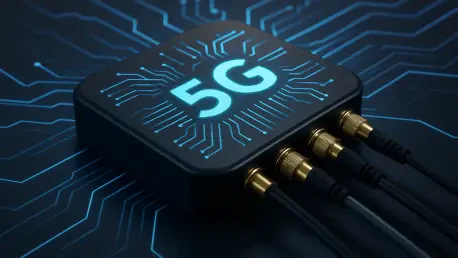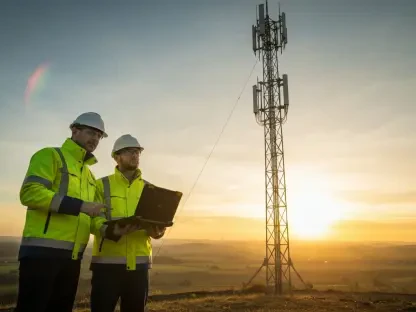In an era where digital connectivity is the backbone of nearly every facet of life, the emergence of 5G technology stands as a monumental shift, promising to redefine how data is accessed and utilized across the globe. At the core of this transformative wave are 5G modems, the critical hardware that fuels this next-generation network with unparalleled capabilities. These devices are far more than incremental upgrades to their predecessors; they are the catalysts for a new age of hyper-connectivity, delivering lightning-fast internet speeds, slashing latency to near-invisible levels, and supporting a staggering array of applications that were once confined to the realm of science fiction. From personal gadgets like smartphones to complex industrial systems powering smart factories, 5G modems are laying the groundwork for a future where seamless, instantaneous communication is the norm. This technological leap is not just about enhancing existing systems but about unlocking innovative possibilities that reshape industries, empower individuals, and redefine societal interactions with the digital world.
Unleashing Unmatched Speed and Latency
The defining strength of 5G modems lies in their ability to provide internet speeds and latency reductions that were unimaginable with earlier network generations. By harnessing wider bandwidths, these modems achieve download and upload speeds that dwarf those of 4G, enabling effortless streaming of ultra-high-definition content, swift file transfers, and real-time collaboration across vast distances. Latency, the delay in data transmission, is reduced to mere milliseconds, a critical advancement for applications requiring split-second responses. Sectors such as online gaming, where every millisecond counts for competitive advantage, and telemedicine, where real-time precision can save lives during remote surgeries, stand to benefit immensely. This leap in performance is not merely a convenience but a foundational shift that redefines the boundaries of digital interaction, setting a new standard for what connectivity can achieve in time-sensitive environments.
Beyond the raw numbers of speed and latency, the implications of 5G modems extend into how they enable a smoother, more reliable digital experience across diverse scenarios. For businesses, this means instantaneous cloud-based operations, allowing teams to collaborate on massive datasets without the frustrating delays that plagued older networks. In public safety, emergency response systems can leverage this low-latency connectivity to coordinate disaster responses with unprecedented efficiency, ensuring critical information reaches the right hands without a hitch. Even in everyday consumer use, the difference is palpable—buffering becomes a relic of the past as high-bandwidth activities like live-streaming events or downloading large files happen in the blink of an eye. The significance of these advancements lies in their ability to remove long-standing barriers, creating a digital landscape where speed and responsiveness are no longer limiting factors but empowering tools for progress.
Transforming Mobile Broadband for All
For both casual users and professionals, 5G modems are reshaping the mobile broadband experience into something far richer and more dynamic than ever before. Integrated into smartphones, tablets, and laptops, these modems support the seamless consumption of high-resolution content, immersive virtual reality experiences, and crystal-clear video calls, all without the stutters or interruptions that characterized older networks. Content creators, including journalists reporting from remote areas and videographers capturing live events, now have the ability to upload and broadcast high-quality media in real time, breaking news or sharing stories as they unfold. Travelers, too, benefit from real-time augmented reality tools that overlay navigation or translation directly onto their surroundings with minimal lag. This enhanced connectivity is not just a luxury but a powerful enabler of personal expression and professional outreach in a mobile-first world.
The broader impact of this mobile broadband transformation is evident in how it democratizes access to cutting-edge digital tools across varied demographics. Students in rural areas can now participate in virtual classrooms with the same high-definition clarity as their urban counterparts, bridging educational gaps through reliable, high-speed access. Small businesses, often constrained by limited resources, gain the ability to compete on a larger stage by leveraging cloud-based services and real-time customer engagement tools powered by 5G modems. Additionally, the entertainment industry sees a surge in innovation as creators experiment with interactive, data-heavy formats that captivate audiences in new ways. This widespread enhancement of mobile connectivity underscores the role of 5G modems as a unifying force, ensuring that the benefits of advanced technology are not confined to specific sectors but are accessible to anyone with a compatible device, fostering inclusivity in the digital age.
Powering the Future of Autonomous Vehicles
In the rapidly evolving field of transportation, 5G modems play an indispensable role in advancing autonomous vehicle technology toward mainstream adoption. Their ability to deliver ultra-low latency and high-speed data transfer is crucial for self-driving cars, which must process vast amounts of real-time information about traffic patterns, weather conditions, and road hazards in an instant. Through vehicle-to-everything (V2X) communication, these vehicles can interact with other cars, traffic signals, and even pedestrians, creating a networked ecosystem that prioritizes safety and efficiency. The split-second decision-making enabled by 5G connectivity ensures that autonomous systems can react to unexpected changes on the road, such as sudden obstacles or erratic driver behavior, with a precision that mimics or surpasses human reflexes, marking a significant step toward safer roadways.
Moreover, the data processing capabilities of 5G modems extend beyond immediate communication to support the long-term evolution of autonomous vehicles through artificial intelligence and machine learning. These technologies rely on continuous data streams to refine algorithms, allowing vehicles to learn from each journey and improve their navigation and decision-making over time. Urban planners and automotive manufacturers also benefit from the detailed traffic insights gathered via 5G networks, enabling the design of smarter cities with optimized traffic flows and reduced congestion. As this technology scales, the potential for fully autonomous fleets—be it for public transit or delivery services—becomes increasingly tangible, promising to reduce human error and transform how goods and people move. The integration of 5G modems in this sector illustrates their capacity to not only enhance current systems but to lay the foundation for revolutionary changes in mobility.
Setting a New Standard Beyond Past Networks
When placed alongside 3G and 4G technologies, 5G modems signify a profound evolution in the scope and quality of connectivity. While earlier generations brought mobile browsing and streaming into the mainstream, 5G pushes the envelope with capabilities that support uninterrupted 4K and even 8K streaming, catering to the growing demand for ultra-high-definition content. This leap is not just about visual fidelity; it enables complex, data-intensive applications that were previously impractical due to bandwidth limitations. Additionally, these modems incorporate energy-efficient designs that extend battery life in connected devices, addressing a critical concern for users and promoting sustainability in tech development. This combination of performance and efficiency marks 5G as a holistic advancement, redefining expectations for what mobile networks can deliver in both consumer and industrial contexts.
The contrast with past networks also highlights how 5G modems are building a smarter, more integrated digital ecosystem that transcends mere upgrades. Unlike the incremental improvements of previous generations, this technology supports a massive increase in connected devices, facilitating the growth of the Internet of Things (IoT) across homes, cities, and industries. Smart grids can optimize energy distribution in real time, while connected factories enhance automation with minimal downtime, all thanks to the robust infrastructure 5G modems provide. This shift is not just technical but cultural, as societies adapt to a world where constant, reliable connectivity underpins everything from daily routines to large-scale economic systems. By establishing a new benchmark, 5G modems are not merely enhancing communication—they are creating a framework for innovation that will shape technological progress for years to come.
Envisioning the Connected Horizon
Reflecting on the journey of 5G modems, their role in reshaping digital landscapes across industries has been nothing short of groundbreaking. These devices have redefined connectivity by delivering exceptional speeds and minimal latency, empowering everything from personal mobile experiences to complex autonomous systems. Their integration into daily life and industrial applications marked a turning point, proving that connectivity could be both a tool and a transformative force. Looking ahead, the focus should shift to ensuring equitable access to this technology, addressing infrastructure gaps in underserved regions to maximize its societal benefits. Stakeholders across sectors must collaborate to refine security protocols, safeguarding the vast data flows enabled by 5G networks. As adoption continues to grow, investing in scalable solutions will be key to sustaining this momentum, ensuring that the promise of a hyper-connected future becomes a reality for all.









